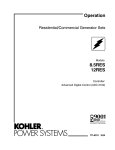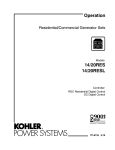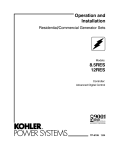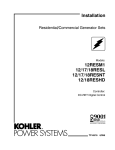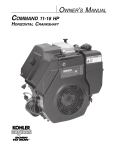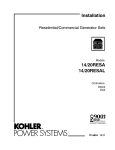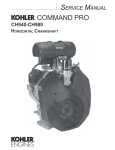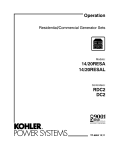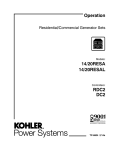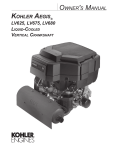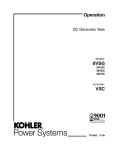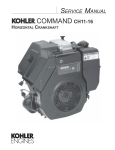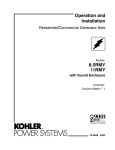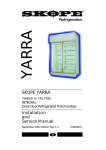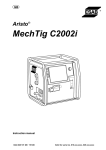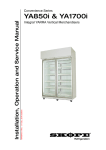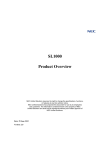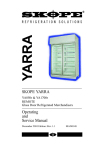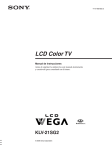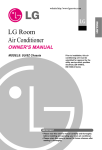Download OPERATION MANUAL
Transcript
E 2009 Lennox Industries Inc. Dallas, Texas 75379-9900 OPERATION MANUAL RGEN12, RGEN17/18 RESIDENTIAL GENERATOR SET XP-6515 4/09a Table of Contents This manual provides operation and maintenance instructions for models RGEN12 and RGEN17/18 generator sets. Generator sets are approved for use in stationary standby applications in locations served by a reliable utility power source. Have a Lennox dealer who is approved to sell and install Lennox generator sets (hereinafter referred to as a Lennox dealer) install the generator set. Refer to XP-6514, Installation Instructions, for installation instructions. Information in this publication represents data available at the time of print. The manufacturer reserves the right to change this publication and the products represented without notice and without any obligation or liability whatsoever. Read this manual and carefully follow all procedures and safety precautions to ensure proper equipment operation and to avoid bodily injury. Read and follow the Safety Precautions and Instructions section. Keep this manual with the equipment for future reference. The equipment service requirements are very important to safe and efficient operation. Inspect the parts often and perform required service at the prescribed intervals. Obtain service from a Lennox dealer to keep equipment in top condition. RETAIN THESE INSTRUCTIONS FOR FUTURE REFERENCE Shipping and Packing List 1 -- Generator Set Check equipment for shipping damage. If you find any damage, immediately contact the last carrier. 506088-01 Product Identification Information . . . . . . . . . . . . . . . Safety Precautions and Instructions . . . . . . . . . . . . . Introduction . . . . . . . . . . . . . . . . . . . . . . . . . . . . . . . . . . . Section 1 Features . . . . . . . . . . . . . . . . . . . . . . . . . . . . . 1.1 Specifications . . . . . . . . . . . . . . . . . . . . . . . . . . . . . 1.2 Generator . . . . . . . . . . . . . . . . . . . . . . . . . . . . . . . . . 1.3 Engine . . . . . . . . . . . . . . . . . . . . . . . . . . . . . . . . . . . 1.4 Controller . . . . . . . . . . . . . . . . . . . . . . . . . . . . . . . . . 1.5 Generator Set Components . . . . . . . . . . . . . . . . . Section 2 Operation . . . . . . . . . . . . . . . . . . . . . . . . . . . . 2.1 Prestart Checklist . . . . . . . . . . . . . . . . . . . . . . . . . . 2.2 Exercising Generator Set . . . . . . . . . . . . . . . . . . . 2.3 Controls and Indicators . . . . . . . . . . . . . . . . . . . . . 2.4 Controller Power . . . . . . . . . . . . . . . . . . . . . . . . . . . 2.5 Generator Set Operation . . . . . . . . . . . . . . . . . . . . 2.6 Faults . . . . . . . . . . . . . . . . . . . . . . . . . . . . . . . . . . . . 2.7 Battery Charger . . . . . . . . . . . . . . . . . . . . . . . . . . . Section 3 Scheduled Maintenance, RGEN12 . . . . . . 3.1 Routine Maintenance . . . . . . . . . . . . . . . . . . . . . . . 3.2 Service Schedule, RGEN12 . . . . . . . . . . . . . . . . . 3.3 Lubrication System . . . . . . . . . . . . . . . . . . . . . . . . . 3.4 Spark Plugs . . . . . . . . . . . . . . . . . . . . . . . . . . . . . . . 3.5 Air Cleaner Element and Precleaner . . . . . . . . . . 3.6 Cooling System . . . . . . . . . . . . . . . . . . . . . . . . . . . . 3.7 Exhaust System . . . . . . . . . . . . . . . . . . . . . . . . . . . 3.8 Battery . . . . . . . . . . . . . . . . . . . . . . . . . . . . . . . . . . . 3.9 Battery Charger . . . . . . . . . . . . . . . . . . . . . . . . . . . 3.10 Circuit Protection . . . . . . . . . . . . . . . . . . . . . . . . . . 3.11 Storage Procedure . . . . . . . . . . . . . . . . . . . . . . . . . Section 4 Scheduled Maintenance, RGEN17/18 . . . 4.1 Routine Maintenance . . . . . . . . . . . . . . . . . . . . . . . 4.2 Service Schedule, RGEN17/18 . . . . . . . . . . . . . . 4.3 Lubrication System . . . . . . . . . . . . . . . . . . . . . . . . . 4.4 Spark Plugs . . . . . . . . . . . . . . . . . . . . . . . . . . . . . . . 4.5 Air Cleaner Service . . . . . . . . . . . . . . . . . . . . . . . . 4.6 Cooling System . . . . . . . . . . . . . . . . . . . . . . . . . . . . 4.7 Exhaust System . . . . . . . . . . . . . . . . . . . . . . . . . . . 4.8 Battery . . . . . . . . . . . . . . . . . . . . . . . . . . . . . . . . . . . 4.9 Battery Charger . . . . . . . . . . . . . . . . . . . . . . . . . . . 4.10 Circuit Protection . . . . . . . . . . . . . . . . . . . . . . . . . . 4.11 Storage Procedure . . . . . . . . . . . . . . . . . . . . . . . . . Section 5 Troubleshooting . . . . . . . . . . . . . . . . . . . . . . 5.1 Introduction . . . . . . . . . . . . . . . . . . . . . . . . . . . . . . . 5.2 Controller Troubleshooting . . . . . . . . . . . . . . . . . . 5.3 Generator Set Troubleshooting . . . . . . . . . . . . . . 5.4 Battery Charger Troubleshooting . . . . . . . . . . . . . 2 3 7 9 9 9 9 9 10 12 12 12 12 13 14 14 17 18 18 19 20 21 21 22 23 23 24 24 25 26 26 27 28 29 30 30 31 31 32 32 33 34 34 34 35 36 California Proposition 65 WARNING Engine exhaust from this product contains chemicals known to the State of California to cause cancer, birth defects, or other reproductive harm. Product Identification Information Product identification numbers determine service parts. Record the product identification numbers in the spaces below immediately after unpacking the products so that the numbers are readily available for future reference. Record field-installed kit numbers after installing the kits. Generator Set Identification Numbers Record the product identification numbers from the generator set nameplate(s). Record the controller description from the generator set operation manual, spec sheet, or sales invoice. Controller Description Engine Identification Record the product identification information from the engine nameplate. Manufacturer Model Designation Model Designation Specification Number Serial Number Accessory Number Controller Identification Serial Number Accessory Description Safety Precautions and Instructions IMPORTANT SAFETY INSTRUCTIONS. Electromechanical equipment, including generator sets, transfer switches, switchgear, and accessories, can cause bodily harm and pose life-threatening danger when improperly installed, operated, or maintained. To prevent accidents be aware of potential dangers and act safely. Read and follow all safety precautions and instructions. SAVE THESE INSTRUCTIONS. This manual has several types of safety precautions and instructions: Danger, Warning, Caution, and Notice. Accidental Starting WARNING Accidental starting. Can cause severe injury or death. Disconnect the battery cables before working on the generator set. Remove the negative (--) lead first when disconnecting the battery. Reconnect the negative (--) lead last when reconnecting the battery. DANGER Danger indicates the presence of a hazard that will cause severe personal injury, death, or substantial property damage. WARNING Warning indicates the presence of a hazard that can cause severe personal injury, death, or substantial property damage. CAUTION Caution indicates the presence of a hazard that will or can cause minor personal injury or property damage. Disabling the generator set. Accidental starting can cause severe injury or death. Before working on the generator set or connected equipment, disable the generator set as follows: (1) Move the generator set master switch to the OFF position. (2) Disconnect the power to the battery charger. (3) Remove the battery cables, negative (--) lead first. Reconnect the negative (--) lead last when reconnecting the battery. Follow these precautions to prevent starting of the generator set by an automatic transfer switch, remote start/stop switch, or engine start command from a remote computer. Battery NOTICE Notice communicates installation, operation, or maintenance information that is safety related but not hazard related. Safety decals affixed to the equipment in prominent places alert the operator or service technician to potential hazards and explain how to act safely. The decals are shown throughout this publication to improve operator recognition. Replace missing or damaged decals. XP-6515 4/09 WARNING WARNING Explosion. Can cause severe injury or death. Relays in the battery charger cause arcs or sparks. Locate the battery in a well-ventilated area. Isolate the battery charger from explosive fumes. Battery electrolyte is a diluted sulfuric acid. Battery acid can cause severe injury or death. Battery acid can cause blindness and burn skin. Always wear splashproof safety goggles, rubber gloves, and boots when servicing the battery. Do not open a sealed battery or mutilate the battery case. If battery acid splashes in the eyes or on the skin, immediately flush the affected area for 15 minutes with large quantities of clean water. Seek immediate medical aid in the case of eye contact. Never add acid to a battery after placing the battery in service, as this may result in hazardous spattering of battery acid. Battery acid cleanup. Battery acid can cause severe injury or death. Battery acid is electrically conductive and corrosive. Add 500 g (1 lb.) of bicarbonate of soda (baking soda) to a container with 4 L (1 gal.) of water and mix the neutralizing solution. Pour the neutralizing solution on the spilled battery acid and continue to add the neutralizing solution to the spilled battery acid until all evidence of a chemical reaction (foaming) has ceased. Flush the resulting liquid with water and dry the area. Sulfuric acid in batteries. Can cause severe injury or death. Wear protective goggles and clothing. Battery acid may cause blindness and burn skin. Safety Precautions and Instructions 3 Battery gases. Explosion can cause severe injury or death. Battery gases can cause an explosion. Do not smoke or permit flames or sparks to occur near a battery at any time, particularly when it is charging. Do not dispose of a battery in a fire. To prevent burns and sparks that could cause an explosion, avoid touching the battery terminals with tools or other metal objects. Remove all jewelry before servicing the equipment. Discharge static electricity from your body before touching batteries by first touching a grounded metal surface away from the battery. To avoid sparks, do not disturb the battery charger connections while the battery is charging. Always turn the battery charger off before disconnecting the battery connections. Ventilate the compartments containing batteries to prevent accumulation of explosive gases. Battery short circuits. Explosion can cause severe injury or death. Short circuits can cause bodily injury and/or equipment damage. Disconnect the battery before generator set installation or maintenance. Remove all jewelry before servicing the equipment. Use tools with insulated handles. Remove the negative (--) lead first when disconnecting the battery. Reconnect the negative (--) lead last when reconnecting the battery. Never connect the negative (--) battery cable to the positive (+) connection terminal of the starter solenoid. Do not test the battery condition by shorting the terminals together. Engine Backfire/Flash Fire WARNING Fire. Can cause severe injury or death. Do not smoke or permit flames or sparks near fuels or the fuel system. Servicing the fuel system. A flash fire can cause severe injury or death. Do not smoke or permit flames or sparks near the carburetor, fuel line, fuel filter, fuel pump, or other potential sources of spilled fuels or fuel vapors. Catch fuels in an approved container when removing the fuel line or carburetor. Combustible materials. A fire can cause severe injury or death. Generator set engine fuels and fuel vapors are flammable and explosive. Handle these materials carefully to minimize the risk of fire or explosion. Equip the compartment or nearby area with a fully charged fire extinguisher. Select a fire extinguisher rated ABC or BC for electrical fires or as recommended by the local fire code or an authorized agency. Train all personnel on fire extinguisher operation and fire prevention procedures. Exhaust System WARNING Carbon monoxide symptoms. Carbon monoxide can cause severe nausea, fainting, or death. Carbon monoxide is a poisonous gas present in exhaust gases. Carbon monoxide is an odorless, colorless, tasteless, nonirritating gas that can cause death if inhaled for even a short time. Carbon monoxide poisoning symptoms include but are not limited to the following: D Light-headedness, dizziness D Physical fatigue, weakness in joints and muscles D Sleepiness, mental fatigue, inability to concentrate or speak clearly, blurred vision D Stomachache, vomiting, nausea If experiencing any of these symptoms and carbon monoxide poisoning is possible, seek fresh air immediately and remain active. Do not sit, lie down, or fall asleep. Alert others to the possibility of carbon monoxide poisoning. Seek medical attention if the condition of affected persons does not improve within minutes of breathing fresh air. Fuel System WARNING Carbon monoxide. Can cause severe fainting, or death. nausea, The exhaust system must be leakproof and routinely inspected. Generator set operation. Carbon monoxide can cause severe nausea, fainting, or death. Carbon monoxide is an odorless, colorless, tasteless, nonirritating gas that can cause death if inhaled for even a short time. Avoid breathing exhaust fumes when working on or near the generator set. Never operate the generator set inside a building. Never operate the generator set where exhaust gas could seep inside or be drawn into a potentially occupied building through windows, air intake vents, or other openings. Explosive fuel vapors. Can cause severe injury or death. Use extreme care when handling, storing, and using fuels. Gas fuel leaks. Explosive fuel vapors can cause severe injury or death. Fuel leakage can cause an explosion. Check the LP vapor gas or natural gas fuel system for leakage by using a soap and water solution with the fuel system test pressurized to 6--8 ounces per square inch (10--14 inches water column). Do not use a soap solution containing either ammonia or chlorine because both prevent bubble formation. A successful test depends on the ability of the solution to bubble. Servicing the air cleaner. A sudden backfire can cause severe injury or death. Do not operate the generator set with the air cleaner removed. 4 Safety Precautions and Instructions XP-6515 4/09 Hazardous Noise CAUTION CAUTION Hazardous noise. Can cause hearing loss. Never operate the generator set without a muffler or with a faulty exhaust system. Engine noise. Hazardous noise can cause hearing loss. Generator sets not equipped with sound enclosures can produce noise levels greater than 105 dBA. Prolonged exposure to noise levels greater than 85 dBA can cause permanent hearing loss. Wear hearing protection when near an operating generator set. Hazardous Voltage/ Moving Parts WARNING Hazardous voltage. Moving parts. Can cause severe injury or death. Operate the generator set only when all guards and electrical enclosures are in place. WARNING Hazardous voltage. Backfeed to the utility system can cause property damage, severe injury, or death. Welding the generator set. Can cause severe electrical equipment damage. Never weld components of the generator set without first disconnecting the battery, controller wiring harness, and engine electronic control module (ECM). Grounding electrical equipment. Hazardous voltage can cause severe injury or death. Electrocution is possible whenever electricity is present. Ensure you comply with all applicable codes and standards. Electrically ground the generator set, transfer switch, and related equipment and electrical circuits. Turn off the main circuit breakers of all power sources before servicing the equipment. Never contact electrical leads or appliances when standing in water or on wet ground because these conditions increase the risk of electrocution. Welding on the generator set. Can cause severe electrical equipment damage. Before welding on the generator set perform the following steps: (1) Remove the battery cables, negative (--) lead first. (2) Disconnect all engine electronic control module (ECM) connectors. (3) Disconnect all generator set controller and voltage regulator circuit board connectors. (4) Disconnect the engine batterycharging alternator connections. (5) Attach the weld ground connection close to the weld location. Connecting the battery and the battery charger. Hazardous voltage can cause severe injury or death. Reconnect the battery correctly, positive to positive and negative to negative, to avoid electrical shock and damage to the battery charger and battery(ies). Have a qualified electrician install the battery(ies). Short circuits. Hazardous voltage/current can cause severe injury or death. Short circuits can cause bodily injury and/or equipment damage. Do not contact electrical connections with tools or jewelry while making adjustments or repairs. Remove all jewelry before servicing the equipment. Electrical backfeed to the utility. Hazardous backfeed voltage can cause severe injury or death. Install a transfer switch in standby power installations to prevent the connection of standby and other sources of power. Electrical backfeed into a utility electrical system can cause severe injury or death to utility personnel working on power lines. WARNING Airborne particles. Can cause severe blindness. injury or Wear protective goggles and clothing when using power tools, hand tools, or compressed air. Heavy Equipment WARNING Unbalanced weight. Improper lifting can cause severe injury or death and equipment damage. Do not use lifting eyes. Lift the generator set using lifting bars inserted through the lifting holes on the skid. If the generator set is used for standby power, install an automatic transfer switch to prevent inadvertent interconnection of standby and normal sources of supply. XP-6515 4/09 Safety Precautions and Instructions 5 Hot Parts WARNING Notice NOTICE Canadian installations only. For standby service connect the output of the generator set to a suitably rated transfer switch in accordance with Canadian Electrical Code, Part 1. Hot engine and exhaust system. Can cause severe injury or death. Do not work on the generator set until it cools. Servicing the exhaust system. Hot parts can cause severe injury or death. Do not touch hot engine parts. The engine and exhaust system components become extremely hot during operation. Servicing the engine heater. Hot parts can cause minor personal injury or property damage. Install the heater before connecting it to power. Operating the heater before installation can cause burns and component damage. Disconnect power to the heater and allow it to cool before servicing the heater or nearby parts. 6 Safety Precautions and Instructions XP-6515 4/09 Introduction Nameplate The following illustration shows a typical generator set nameplate. Copy the model, serial, and specification numbers from the nameplate into the spaces provided in the product information section on the inside front cover of this manual. See Figure 1-1 or Figure 1-2 for the nameplate location. Emission Compliance, RGEN12 All model RGEN12 generator sets with multi-fuel systems are emission-certified. An engine or generator set with the following identification label is certified to meet Small Off-Road Engine emission standards for EPA/CARB. IMPORTANT ENGINE INFORMATION THIS ENGINE MEETS U.S. EPA PH2 AND CA 2008 AND LATER EXH EMISSION REGS FOR SI SORE FAMILY DISPL (CC) MODEL NO. SPEC NO. SERIAL NO. BUILD DATE N11236 EMISSION COMPLIANCE PERIOD: EPA: CATEGORY A CARB: EXTENDED CERTIFIED ON: LPG / NATURAL GAS REFER TO OWNER’S MANUAL FOR HP RATING, SAFETY, MAINTENANCE, AND ADJUSTMENTS 1-800-544-2444 KohlerEngines.com KOHLER CO. KOHLER WISCONSIN USA Figure 1 tp6515 Emissions Label, RGEN12 Engine (CH740) This engine/generator is certified to operate using natural gas or propane fuel. The Emission Compliance Period referred to on the Emission Control or Air Index label indicates the number of operating hours for which the engine has been shown to meet CARB emission requirements. The following table provides the engine compliance period (in hours) associated with the category descriptor found on the certification label. Emission Compliance Period, Hour CARB Figure 2 Moderate, 125 Intermediate, 250 Extended, 500 RGEN12 Refer to the certification label for engine displacement. The exhaust emission control system for the CH 740 engine is EM. XP-6515 4/09 Introduction 7 Emission Compliance, RGEN17/18 The RGEN17/18 generator set engine is certified to meet emission regulations for U.S. EPA phase 2 small off-road engines and CA 2006 and later LSI engines (large spark-ignited engines at or below 1 liter). The Emission Compliance Period referred to on the engine identification label indicates the number of operating hours for which the engine has been shown to meet EPA emission requirements. The engine compliance period (in hours), associated with the Category A descriptor found on the certification label, is 1000 hours. Refer to the certification label for engine displacement. The exhaust emission control system for the CH980 engine is EM. Figure 3 8 Engine Identification Label, RGEN17/18 Introduction XP-6515 4/09 Section 1 Features 1.1 Specifications The generator set specification sheets provide specific generator and engine information. Refer to the spec sheet for data not supplied in this manual. Consult the generator set service manual, engine operation manual, and engine service manual for additional specifications. Obtain copies of the latest spec sheets, manuals, diagrams, and drawings from a Lennox dealer. 1.4 Controller Controller features include the following: D Compact controller D Integrally mounted to the generator set D LED display: D Engine runtime, hours D AC voltage 1.2 Generator The generator uses a unique voltage regulation system, which provides instant response to load changes. This unique voltage regulation system ensures reliable motor starting and consistent voltage levels. It utilizes a voltage excitation system that employs a winding independent of the main output windings to provide excitation voltage. 1.3 Engine The generator set has a four-cycle, twin cylinder, aircooled Kohlerr engine. The engine operates on cleanburning natural gas or propane (LP) vapor. Engine features include: D Efficient overhead valve design and full pressure lubrication for maximum power, torque, and reliability under all operating conditions. D Dependable, maintenance-free electronic ignition. D Precision-formulated cast iron construction of parts subjected to the most wear and tear. D Frequency (Hz) D Battery voltage D Crank cycle status D Setup information D Application software version D LED display communicates faults: D High battery voltage D High engine temperature D Low battery voltage D Low oil pressure D Overcrank safety D Overfrequency D Overspeed D Overvoltage D Underfrequency D Undervoltage D Membrane keypad for configuration and adjustment D Password-protected user access to menus D Voltage, gain, and speed adjustment D System configuration (system voltage/frequency settings and generator set model) D Remote two-wire start/stop capability D Field-convertible multi-fuel systems that allow fuel D Digital isochronous governor to maintain steady- changeover from natural gas to LP vapor (and viceversa) while maintaining CARB emission certification. D Digital voltage regulation: ±1.5% RMS no-load to D Digital spark advance optimizes ignition timing for the selected fuel. state speed at all loads full-load D Automatic start for programmed cranking cycle D Master control switch mounted on the junction box: Run/Off-Reset/Auto D Upgradeable application software XP-6515 4/09 Section 1 Features 9 1.5 Generator Set Components 1 2 3 4 5 6 17 7 16 19 19 20 21 8 22 9 10 15 24 23 ADV-7466- 23 1. 2. 3. 4. 5. 6. 7. 8. 9. 10. 11. 12. 13 12 11 Muffler Oil check Oil fill Air cleaner Fuses RS-232 connector (for application program updates) Controller user interface (see Figure 2-1) Generator set master switch (RUN-OFF/RESET-AUTO) Load circuit breaker Field-connection terminal block location Spark plug locations (both sides) Oil drain hose Figure 1-1 10 14 13. 14. 15. 16. 17. 18. 19. 20. 21. 22. 23. 24. Oil drain valve Oil filter Exhaust Equipment ground Battery charger DSAI lead location Fuel block Gas regulator assembly Fuel solenoid valve Fuel inlet Air intake Engine starting battery location (battery purchased separately) Generator Set Components, RGEN12 Section 1 Features XP-6515 4/09 8 Control detail, top view 12 9 11 10 1 2 3 4 5 6 7 See control detail 18 19 20 21 22 23 28 27 26 24 17 24 ADV-7341A-B 24 1. 2. 3. 4. 5. 6. 7. 8. 9. 10. 11. 12. 13. 14. 15. 16 15 14 Muffler Oil check Oil fill Air cleaner Spark plug locations (both sides) Oil filter Oil cooler location Controller user interface Generator set master switch (RUN-OFF/RESET-AUTO) Line circuit breaker Fuses RS-232 connector (for application program updates) Engine starting battery location (battery purchased separately) Oil drain hose Nameplate location (on base) Figure 1-2 XP-6515 4/09 13 16. 17. 18. 19. 20. 21. 22. 23. 24. 25. 26. 27. 28. 25 Oil drain valve Exhaust outlet Carburetor heater access opening LP fuel orifice location (inside hose fitting) Gas regulator assembly DSAI leads Fuel solenoid valve Fuel inlet Air intake Battery cables Battery charger Field-connection terminal block location 120 VAC receptacles for battery charger and optional carburetor heater Generator Set Components, RGEN17/18 Section 1 Features 11 Section 2 Operation 2.1 Prestart Checklist To ensure continued satisfactory operation, perform the following checks or inspections before or at each startup, as designated, and at the intervals specified in the service schedule. In addition, some checks require verification after the unit starts. 2.3 Controls and Indicators Figure 2-1 illustrates the user interface and other items on the generator set junction box. Figure 2-2 describes the controls and indicators. 1 Air Cleaner. Check for a clean and installed air cleaner element to prevent unfiltered air from entering the engine. 2 7 Air Inlets. Check for clean and unobstructed air inlets. Battery. Check for tight battery connections. Consult the battery manufacturer’s instructions regarding battery care and maintenance. 6 Exhaust System. Check for exhaust leaks and blockages. Check the muffler condition and check for tight exhaust system connections. 5 3 Inspect the exhaust system components for cracks, leaks, and corrosion. 4 D Check for corroded or broken metal parts and replace them as needed. D Check that the exhaust outlet is unobstructed. Oil Level. Maintain the oil level at or near, not over, the full mark on the dipstick. Operating Area. Check for obstructions that could block the flow of cooling air. Keep the air intake area clean. Do not leave rags, tools, or debris on or near the generator set. 2.2 Exercising Generator Set Operate the generator set without load once each week for 20 minutes. If the generator set is not connected to an automatic transfer switch (ATS) with an exercise option, exercise the unit in the presence of an operator. The operator should perform all of the prestart checks before starting the exercise procedure. Start the generator set according to the starting procedure in the controller section of this manual. While the generator set is operating, listen for a smooth-running engine and visually inspect the generator set for fluid or exhaust leaks. Check the air inlets and outlets and remove any items restricting the air flow. 12 Section 2 Operation 1. 2. 3. 4. 5. 6. 7. LED display Up and down arrow buttons Generator set master switch Line circuit breaker Fuses RS-232 connector (for application program upgrade) Select button (use for setup and adjustment only) Figure 2-1 2.3.1 Controls LED Display The LED display is activated by a start or RUN command as follows: D Move the master switch to RUN. D With the master switch in AUTO, send a remote start command (close the remote start contact across leads 3 and 4). The LED display indicates generator set status as shown in Figure 2-2. When the generator set is running, engine runtime hours are shown unless the arrow buttons are used to step through the other displays as described in Section 2.3.2. When the master switch is in AUTO, the display turns off 48 hours after generator set shutdown. See Section 2.4, Controller Power. XP-6515 4/09 Control or Indicator Item Description LED display Runtime hours Displays total generator set runtime hours while the generator set is running and when no other codes are displayed. Metering display Displays AC voltage (output), frequency, and battery voltage. Press the up or down arrow when runtime hours are displayed to step through these displays. Crank indication Displays CC_1, CC_2, or CC_3 to indicate the first, second, or third attempt to start the engine. The last digit flashes during the crank cycle rest periods. Keypad Generator set master switch Figure 2-2 2.3.2 Software version number The software version number (v#.##) is displayed when entering configuration mode. See the installation manual. Fault codes Flashes a 2- or 3-letter fault code to indicate various fault conditions. See Section 2.6. Select and arrow buttons Use the arrow buttons to step through the data displays. See Figure 2-3. Three-position switch Switch functions as the generator set operation and controller reset switch. The keypad is also used for controller setup and adjustment. The setup and adjustment functions are password-protected. Have setup and adjustments performed only by a Lennox dealer. Controls and Indicators Controller Keypad The three buttons on the controller keypad are Select, Up, and Down. When the generator set is running, the up and down arrow buttons can be used to step through system data displays as shown in Figure 2-3. After 10 seconds, the display returns to engine runtime hours. The buttons on the controller keypad are also used for system configuration and adjustment. The system configuration is factory-set and should not require changes under normal operating conditions. Contact a Lennox dealer or service technician if adjustments are required. 2.3.3 Generator Set Master Switch The generator set master switch is located on the junction box below the user interface. The master switch positions are RUN, OFF/RESET, and AUTO. See Section 2.5 for operation instructions. Engine Runtime XXX.X hours 2.4 Controller Power Output Voltage VAC The controller is powered by the generator set engine starting battery. Output Frequency Hz Note: The generator sets are equipped with factoryinstalled battery chargers to prevent battery discharge. The battery charger must be connected to utility power. Battery Voltage VDC 2.4.1 tp6515 1. Generator set master switch in AUTO 2. Step through using up or down arrow buttons 3. After 10 seconds, display returns to runtime hours Figure 2-3 XP-6515 4/09 Data Displays Standby Mode When the generator set master switch is in the AUTO position and the engine is not running, the controller is in standby mode. Engine runtime hours are shown on the display. A remote start signal (contact closure) will start and run the generator set. The controller can be set to go into sleep mode if there is no start signal for 48 hours. Section 2 Operation 13 2.4.2 Sleep Mode Controllers with application code version 1.13 or higher are shipped with the sleep mode disabled and J1939 communication enabled. The controller will remain in standby mode whenever the master switch is in AUTO and the engine is not running. Note: The battery charger must be connected to utility power to prevent battery discharge. Communication parameter Cn can be changed to disable communication and enable the sleep mode if remote communication is not required. See Installation Manual XP-6514 for instructions to set parameter Cn. Sleep Mode. If the controller communication is disabled and the generator set master switch is in the AUTO position, the controller powers down automatically after 48 hours of inactivity. The controller display is dark and battery draw is minimized. A remote start signal (from a transfer switch or a remote start/stop switch connected to controller leads 3 and 4) reactivates the controller. Moving the generator set master switch to the RUN position also activates the controller. 2.5 Generator Set Operation 2.5.1 Starting Generator Set Local Starting Move the generator set master switch to the RUN position to immediately start the generator set. Auto (Automatic) Starting Move the generator set master switch to the AUTO position to allow startup by an automatic transfer switch (ATS) or remote start/stop switch, if equipped. Close a contact across engine start leads 3 and 4 to signal the controller to start the generator set. Crank Cycle The controller attempts to start the generator set three times (three crank cycles, 15 seconds crank and 15 seconds off). See Figure 2-2 for display information during the crank cycle. If the generator set does not start in three attempts, the system shuts down on an overcrank fault. See Section 2.6. 2.5.2 2. Move the generator set master switch to the OFF/ RESET position. The engine stops. Automatic Stopping With the generator set master switch in the AUTO position, open the contact across engine start leads 3 and 4 to signal the generator set to stop. An automatic transfer switch (ATS) connected to controller leads 3 and 4 operates as follows: 1. The ATS disconnects the load from the generator set. 2. If the ATS is equipped with an engine cooldown time delay, the generator set continues to run for a preset engine cooldown time. Note: There is no engine cooldown time delay on the controller. 3. The ATS opens the connection between controller leads 3 and 4. The generator set shuts down. The controller enters standby mode and displays engine runtime hours. 2.6 Faults 2.6.1 Shutdowns Under the fault shutdown conditions listed in Figure 2-4, the generator set shuts down automatically and the controller displays a fault code. The generator set cannot be restarted until the fault condition is corrected and the controller is reset. See Section 2.6.3 to reset the controller after a fault shutdown. The shutdown switches on the generator set will automatically reset when the problem is corrected. For example, the high engine temperature switch resets automatically when the generator set cools. However, the fault does not clear until the controller is reset. 2.6.2 Warnings The controller displays a fault code but the generator set does not shut down on a high battery voltage warning or a low battery voltage warning. The controller resets automatically after a battery voltage fault condition is corrected. Stopping Generator Set Local Stopping 1. Run the generator set with no load for at least 2 minutes to ensure adequate engine cooldown. 14 Section 2 Operation XP-6515 4/09 2.6.3 Resetting Controller after a Fault Shutdown Always identify and correct the cause of a fault shutdown before resetting the controller. Check the fault code displayed on the controller and refer to Figure 2-4 to identify and correct the fault condition before proceeding. Use the following procedure to reset the generator set controller after a fault shutdown. 1. Move the generator set master switch to OFF/ RESET. 2. Disconnect the generator set from the load using the line circuit breaker or ATS. See the safety precautions at the beginning of this manual before proceeding. 4. Start the generator set by moving the generator set master switch to RUN. Test operate the generator set to verify that the cause of the shutdown has been corrected. 5. Move the generator set master switch to OFF/ RESET. 6. Reconnect the generator set to the load using the line circuit breaker or ATS. 7. Move the generator set master switch to the AUTO position for startup by remote transfer switch or remote start/stop switch. Note: The controller’s LED display remains off until an engine start command is received. 3. Identify and correct the cause of the fault shutdown. See the safety precautions at the beginning of this manual before proceeding. Refer to Section 5, Troubleshooting. XP-6515 4/09 Section 2 Operation 15 Code Fault Description Check AF Auxiliary fault input shutdown Not used. — HE High engine temperature shutdown Shutdown occurs if the engine coolant temperature exceeds the maximum temperature for more than 5 seconds. This function becomes active after the engine reaches the crank disconnect speed. Check for blocked air inlets and exhaust outlets. LOP Low oil pressure shutdown Shutdown occurs if a low oil pressure condition exists for more than 5 seconds. This function becomes active 30 seconds after the engine has reached crank disconnect speed (30 second inhibit). Check for leaks in the lubrication system. Check the oil level and add oil if the level is low. Note: The low oil pressure shutdown does not protect against low oil level. Check the oil level at the engine. Overcrank shutdown Shutdown occurs after 3 unsuccessful starting attempts. The crank cycle is set for three starting attempts of 15 seconds cranking and 15 seconds rest. Check the fuel supply, spark plug, and battery. Locked rotor The generator set also shuts down on OC if no engine rotation is sensed during cranking. Shuts down 3 seconds after the fault is detected. Contact a Lennox dealer for service if problem continues. OF Overfrequency shutdown Shutdown occurs when the governed frequency exceeds 110% of the system’s frequency setpoint for more than 5 seconds. This function becomes active 10 seconds after engine start (10 second inhibit). Contact a Lennox dealer for service if problem continues. OS Overspeed shutdown Shutdown occurs if the engine speed exceeds 110% of the normal running speed for more than 0.3 seconds. Contact a Lennox dealer for service if problem continues. OU Overvoltage shutdown Shutdown occurs if the voltage exceeds 120% of the system nominal voltage for more than 2 seconds. Contact a Lennox dealer for service if problem continues. UF Underfrequency Shutdown occurs if the governed frequency falls below shutdown 54 Hz for more than 5 seconds. OC Check for loose connections. Reduce the load and restart the generator set. Shutdown also occurs if the governed frequency falls below Contact a Lennox dealer for service if 56.5 Hz for more than 60 seconds. problem continues. This function becomes active 10 seconds after engine start. (10 second inhibit). UU Undervoltage shutdown Shutdown occurs if the voltage falls below 80% of the nominal system voltage for more than 10 seconds. Reduce the load and restart the generator set. Contact a Lennox dealer for service if problem continues. HB High battery Fault code is displayed if the engine starting battery voltage Check the battery rating and voltage warning rises above 16 VDC for more than 30 seconds when the condition. engine is running. Not operative during the engine crank Check the battery charger operation. cycle, this fault condition does not inhibit engine starting. The fault condition clears when the battery voltage returns to an acceptable level. LB Low battery Fault code is displayed if the engine starting battery voltage voltage warning falls below 11 VDC for more than 30 seconds when the engine is not running. Not operative during the engine crank cycle, this fault condition does not inhibit engine starting. Check the battery rating and condition. Check the battery charger operation. Charge or replace the battery. The fault condition clears when the battery voltage returns to an acceptable level. Figure 2-4 16 Controller Fault Codes Section 2 Operation XP-6515 4/09 2.7 Battery Charger The generator set is equipped with a 6-amp float/equalize battery charger to maintain the engine starting battery. The charger’s power cord must be connected to a 120 VAC power source. Figure 2-5 illustrates the battery charger. The battery charger uses an AGS 10 inline fuse. The fuse is located in the battery lead. See Figure 2-5. 1 INDICATOR Red: Red & Green: Green: VOLTS= 11.8--14.0 AMPS= 5.0--6.0 VOLTS= 14.0--14.5 AMPS= 1.5--5.0 VOLTS= 13.0--13.6 AMPS= 0.1--1.5 6 AMP AUTOMATIC BATTERY CHARGER CAUTION: To reduce the risk of elect rical shock, connect only to properly gr ounded outlet. INPUT: 115 VAC 50/60Hz @ 1.6A OUTPUT: 12 VDC @ 6 Amps MAX. BAT.: 180 Amp Hr. Max. DATE: Allowable Battery Types: Lead Acid a C Display Operating Condition Red ON Green OFF When the red LED is on, it indicates the battery is discharged and the battery charger is recharging at the BULK rate (stage 1). This charging rate is 6 amps. While the red LED is on, the voltage measured (with the battery charger on) will be 11.8--14 volts. If the red LED stays on for more than 24 hours, refer to Section 5.4 in this manual. Red ON When both the green and the red LEDs are Green ON on, the battery charger is charging at an ABSORPTION rate of between 1.5 and 5 amps (stage 2). This mode of charging gradually tops off your battery, and reduces harmful sulfating. While both LEDs are on, the voltage measured (with the battery charger on) should be approximately 14.0--14.5 VDC. If both LEDs stay on longer than 24 hours, refer to Section 5.4 in this manual. R US LISTED BATTERY CHARGER 53AB 2608KH nd Gel Cell 4 2 3 Red OFF When the green LED is on, the battery Green ON charger is charging at a FLOAT or MAINTENANCE rate of less than 1.5 amps (stage 3). Your battery is now 90% charged and ready for use. This float charging current will gradually decrease to as low as 0.1 amps as the battery reaches 100% charge. It will now be kept at full charge without overcharging. If the green LED stays on when your battery is known to be low, refer to Section 5.4 in this manual. 1. 2. 3. 4. LED indicators AC power cord Fuse Battery leads, 12 VDC Figure 2-5 2.7.1 Figure 2-7 Battery Charger LED Indicator Functions 6-Amp Float/Equalize Battery Charger Battery Charger Operation Figure 2-6 illustrates the three-stage charging method. Red and green LEDs indicate charger operation. The chart in Figure 2-7 describes the LED indicator operation during each stage of the charging process. Figure 2-6 XP-6515 4/09 Charging Method Section 2 Operation 17 Section 3 Scheduled Maintenance, RGEN12 WARNING Servicing the exhaust system. Hot parts can cause severe injury or death. Do not touch hot engine parts. The engine and exhaust system components become extremely hot during operation. WARNING Accidental starting. Can cause severe injury or death. Disconnect the battery cables before working on the generator set. Remove the negative (--) lead first when disconnecting the battery. Reconnect the negative (--) lead last when reconnecting the battery. Disabling the generator set. Accidental starting can cause severe injury or death. Before working on the generator set or connected equipment, disable the generator set as follows: (1) Move the generator set master switch to the OFF position. (2) Disconnect the power to the battery charger. (3) Remove the battery cables, negative (--) lead first. Reconnect the negative (--) lead last when reconnecting the battery. Follow these precautions to prevent starting of the generator set by an automatic transfer switch, remote start/stop switch, or engine start command from a remote computer. WARNING Hot engine and exhaust system. Can cause severe injury or death. Hazardous voltage. Moving parts. Can cause severe injury or death. Operate the generator set only when all guards and electrical enclosures are in place. Servicing the generator set when it is operating. Exposed moving parts can cause severe injury or death. Keep hands, feet, hair, clothing, and test leads away from the belts and pulleys when the generator set is running. Replace guards, screens, and covers before operating the generator set. 3.1 Routine Maintenance Refer to the following service schedule and the runtime hours displayed on the controller display to schedule routine maintenance. Have a Lennox dealer service the generator set at the designated intervals in the service schedule for the life of the generator set. Service units subject to extreme weather, long operating hours, or dusty or dirty conditions more frequently. Contact a Lennox dealer for parts. Do not work on the generator set until it cools. 18 Section 3 Scheduled Maintenance, RGEN12 XP-6515 4/09 3.2 Service Schedule, RGEN12 Procedure System Component or Procedure Fuel See Section Visually Inspect Check Change Clean Test Flexible lines and connections X Main tank supply level Quarterly X Fuel piping Lubrication R Frequency Weekly X Yearly 3.3 Oil level X Crankcase breather hose 8 hours or before use X X Yearly or 500 hours Change oil X Yearly or 100 hours Replace filter X Yearly or 200 hours Cooling 3.6 Air ducts, louvers Exhaust Line X X Yearly 3.7 Leakage X Insulation, fire hazards X Yearly Obstructions or combustible materials near exhaust outlet X Weekly DC Electrical System X Weekly 3.8 Battery charger operation, charge rate (if equipped) X Remove corrosion, clean and dry battery and rack X Clean and tighten battery terminals and inspect boots X Battery electrolyte level and specific gravity * Monthly X Yearly X Yearly X Yearly AC Electrical System Tighten control and power wiring connections X Yearly Remote control system, if equipped X Visible wear or damage X Wire abrasions where subject to motion X Wire-cable insulation condition X Monthly Quarterly X Six Months 3 Years or 500 hours Engine and Mounting Visible wear or damage X Air cleaner and precleaner service 3.5 Spark plugs 3.4 Weekly Replace stepper motor coupling and bushing R Yearly or 100 hours X Yearly or 300 hours D 500 hours Generator Visible wear or damage X Quarterly Exercise generator set X Brushes and collector ring D D Measure and record resistance readings of windings with insulation tester (Meggerr, with SCR assembly or rectifier and load leads disconnected) * Weekly Yearly D 3 Years General Condition of Equipment Evidence of vibration, leakage, excessive noise, temperature, or deterioration X Interior of sound enclosure X * Not necessary for maintenance-free batteries. D X R X X Weekly X Quarterly Lennox dealer only Action Replace as necessary Meggerr is a registered trademark of Biddle Instruments. XP-6515 4/09 Section 3 Scheduled Maintenance, RGEN12 19 3.3 Lubrication System 3.3.4 Oil Change Procedure Drain the oil while it is still warm. See Section 3.2, Service Schedule, for oil change and oil filter replacement intervals. See Section 1.5 for the oil drain, oil check, oil fill, and oil filter locations. For extended operation, check the oil level every 8 hours. Maintain the oil level at or near, not over, the full mark on the dipstick. 3.3.1 Low Oil Pressure Shutdown The low oil pressure shutdown feature protects the engine against internal damage if the oil pressure drops below 24.1 kPa ±13.8 kPa (3.5 psi ±1.5 psi) because of oil pump failure or other malfunction. The shutdown feature does not protect against damage caused by operating with the oil level below the safe range; it is not a low oil level shutdown. Check the oil level regularly, and add oil as needed. 3.3.2 1. Drain the oil. a. Place the generator set master switch in the OFF position. b. Disconnect the power to the battery charger. c. Disconnect the generator set engine starting battery, negative (--) lead first. d. Remove the housing side panel. e. Remove the oil drain hose from its retaining clip. Remove the cap from the oil drain hose and lower the hose into an oil collection container. f. Open the oil drain valve on the engine. g. Allow time for the engine oil to drain completely. Oil Check The generator set is shipped with oil. Before operating a new generator set, check the engine oil in the crankcase. See Section 1.5, Generator Set Components. Verify that the oil level is at the F mark on the dipstick. Add oil that has a viscosity appropriate for the climate. See Section 3.3.3, Engine Oil Recommendation. h. Close the oil drain valve. i. Replace the cap on the oil drain hose. Replace the oil drain hose in its retaining clip. 2. Replace the oil filter. a. Remove the oil filter by rotating counterclockwise with an oil filter wrench. it Do not check the oil level when the generator set is running. Shut down the generator set and wait several minutes before checking the oil level. b. Clean the gasket sealing surface of the oil filter adapter. 3.3.3 c. Apply a light coat of clean oil to the rubber seal of the new oil filter. Engine Oil Recommendation Use API (American Petroleum Institute) Service Class SG, SH, or SJ synthetic oil. Synthetic oil oxidizes and thickens less than other oils and leaves the engine intake valves and pistons cleaner. Select the viscosity based on the air temperature at the time of operation. See Figure 3-1. d. Install the new oil filter following the instructions provided with the filter. Note: Dispose of all waste materials (engine oil, fuel, filter, etc.) in an environmentally safe manner. 3. Fill with oil. 10W-30 5W-20, 5W-30 60 80 100 °F --20 0 20 32 40 °C --30 --20 --10 0 10 20 30 40 Temperature Range Expected Before Next Oil Change Figure 3-1 20 a. Remove the oil fill cap and fill the engine to the F mark on the dipstick. The engine oil capacity is 1.9 L (2.0 qt.). See Section 3.3.3, Engine Oil Recommendation, for oil selection. b. Reinstall the dipstick and the oil fill cap. c. Check that the generator set master switch is in the OFF position. Engine Oil Selection Section 3 Scheduled Maintenance, RGEN12 XP-6515 4/09 d. Reconnect the generator set engine starting battery, negative (--) lead last. e. Reconnect the power to the battery charger. f. Start and run the generator set for a minute to allow the oil pressure to reach the operating range. 3.5 Air Cleaner Element and Precleaner The engine has a replaceable high-density paper air cleaner element with an oiled foam precleaner. See Figure 3-4. g. Stop the generator set, wait 1 minute, and then recheck the oil level. Add oil to bring the level up to the F mark on the dipstick. 1 2 4. Check for leaks. 3 a. Check for oil leaks. b. Fix leaks and recheck the oil level. 4 c. Reinstall the housing side panel. 5 3.4 Spark Plugs Reset the spark plug gap or replace the plugs with new plugs as necessary. 6 1. Clean the area around the base of the spark plug to keep dirt and debris out of the engine. 7 2. Remove the spark plug and check its condition. Replace the spark plug if it is worn or if its reuse is questionable. 3. Check the spark plug gap using a wire feeler gauge. Adjust the gap to 0.76 mm (0.030 in.) by carefully bending the ground electrode. See Figure 3-2 and Figure 3-3. 586536 1. 2. 3. 4. 5. 6. 7. Cover knob Air cleaner cover Element cover nut Element cover Foam precleaner Air cleaner element Air cleaner base Figure 3-4 Air Cleaner Components Check for a buildup of dirt and debris around the air cleaner system. Keep this area clean. 1--514 Figure 3-2 Note: Operating the engine with loose or damaged air cleaner components could allow unfiltered air into the engine causing premature wear and failure. Checking the Spark Plug Gap 1--511 Figure 3-3 XP-6515 4/09 Adjusting the Spark Plug Gap Section 3 Scheduled Maintenance, RGEN12 21 3.5.1 Precleaner Service Use the following procedure to wash and reoil the precleaner as indicated in the service schedule. Wash and reoil the precleaner more often under extremely dusty or dirty conditions. 1. Place the generator set master switch in the OFF/ RESET position. 2. Disconnect the power to the battery charger. 3. Disconnect the battery, negative (--) lead first. 4. Loosen the cover retaining knob and remove the cover. Remove the precleaner from the paper element. Wash the precleaner in warm water with detergent. Rinse the precleaner thoroughly until all traces of detergent are eliminated. Squeeze out excess water (do not wring). Allow the precleaner to air dry. 5. Saturate the precleaner with new engine oil. Squeeze out all of the excess oil. 6. Reinstall the precleaner over the paper element. 7. Reinstall the air cleaner cover. Secure the cover with the cover retaining knob. 8. Reconnect the power to the battery charger. 9. Reconnect the generator set engine starting battery, negative (--) lead last. 3.5.2 7. Replace the element if it is dirty, bent, or damaged. 8. Check the air cleaner base. Make sure it is secure and not bent or damaged. Also check the element cover for damage and fit. Replace all damaged air cleaner components. Remove any loose dirt or debris from the air cleaner base. Wipe the base carefully so that no dirt drops into the intake throat. Check the condition of the rubber seal on the air cleaner stud and replace the seal if necessary. 9. Reinstall the paper element, precleaner, element cover, element cover nut, and the air cleaner cover. Secure the cover with the cover retaining knob. 10. Reconnect the power to the battery charger. 11. Reconnect the generator set engine starting battery, negative (--) lead last. 3.6 Cooling System The engine fan draws cooling air through the openings in the sides and end near the battery. The alternator fan draws cooling air through openings on the side walls of the enclosure. The cooling air mixes with the engine exhaust and is discharged at the exhaust outlet. See Figure 3-5. To prevent generator set damage caused by overheating, keep the housing cooling inlets and outlets clean and unobstructed at all times. Note: Do not block the generator set cooling air inlets or mount other equipment above them. Overheating and severe generator damage may occur. Paper Element Service Use the following procedure to replace the paper element at the intervals specified in the service schedule. Replace the paper element more often under extremely dusty or dirty conditions. 3 1 1. Place the generator set master switch in the OFF/ RESET position. 2. Disconnect the power to the battery charger. 3. Disconnect the generator set engine starting battery, negative (--) lead first. 4. Loosen the cover retaining knob and remove the cover. tp6195 2 3 1. Exhaust outlet 2. Alternator air intake (both sides) 3. Engine air intake Figure 3-5 Cooling Air Intake and Exhaust 5. Remove the element cover nut, element cover, and the paper element with precleaner. 6. Remove the precleaner from the paper element. Note: Do not wash the paper element or clean it with pressurized air, as this will damage the element. 22 Section 3 Scheduled Maintenance, RGEN12 XP-6515 4/09 3.7 Exhaust System Remove all combustible materials from the exhaust location. Combustible materials include building materials as well as natural surroundings. Keep dry field grass, foliage, and combustible landscaping material a minimum of 1.5 m (5 ft.) from the exhaust outlet. Periodically inspect the exhaust system components (exhaust manifold, exhaust line, flexible exhaust, clamps, silencer, and outlet pipe) for cracks, leaks, and corrosion. D Check for corroded or broken metal parts and replace them as needed. D Check for loose, corroded, or missing clamps and hangers. Tighten or replace clamps and/or hangers as needed. D Check for and remove loose insulation in the exhaust duct. D Check that the exhaust outlet is clear. 3.8 Battery WARNING Sulfuric acid in batteries. Can cause severe injury or death. Wear protective goggles and clothing. Battery acid may cause blindness and burn skin. Battery electrolyte is a diluted sulfuric acid. Battery acid can cause severe injury or death. Battery acid can cause blindness and burn skin. Always wear splashproof safety goggles, rubber gloves, and boots when servicing the battery. Do not open a sealed battery or mutilate the battery case. If battery acid splashes in the eyes or on the skin, immediately flush the affected area for 15 minutes with large quantities of clean water. Seek immediate medical aid in the case of eye contact. Never add acid to a battery after placing the battery in service, as this may result in hazardous spattering of battery acid. Battery acid cleanup. Battery acid can cause severe injury or death. Battery acid is electrically conductive and corrosive. Add 500 g (1 lb.) of bicarbonate of soda (baking soda) to a container with 4 L (1 gal.) of water and mix the XP-6515 4/09 neutralizing solution. Pour the neutralizing solution on the spilled battery acid and continue to add the neutralizing solution to the spilled battery acid until all evidence of a chemical reaction (foaming) has ceased. Flush the resulting liquid with water and dry the area. Battery gases. Explosion can cause severe injury or death. Battery gases can cause an explosion. Do not smoke or permit flames or sparks to occur near a battery at any time, particularly when it is charging. Do not dispose of a battery in a fire. To prevent burns and sparks that could cause an explosion, avoid touching the battery terminals with tools or other metal objects. Remove all jewelry before servicing the equipment. Discharge static electricity from your body before touching batteries by first touching a grounded metal surface away from the battery. To avoid sparks, do not disturb the battery charger connections while the battery is charging. Always turn the battery charger off before disconnecting the battery connections. Ventilate the compartments containing batteries to prevent accumulation of explosive gases. Battery short circuits. Explosion can cause severe injury or death. Short circuits can cause bodily injury and/or equipment damage. Disconnect the battery before generator set installation or maintenance. Remove all jewelry before servicing the equipment. Use tools with insulated handles. Remove the negative (--) lead first when disconnecting the battery. Reconnect the negative (--) lead last when reconnecting the battery. Never connect the negative (--) battery cable to the positive (+) connection terminal of the starter solenoid. Do not test the battery condition by shorting the terminals together. Refer to this section for general battery information and maintenance. Also consult the battery manufacturer’s instructions for battery maintenance. All generator set models use a negative ground with a 12-volt engine electrical system. Consult the generator set nameplate for the engine electrical system voltage. Consult the generator spec sheet for battery capacity recommendations for replacement purposes. Wiring diagrams provide battery connection information. See Figure 3-6 for typical battery connections. 1 2 EZ-273000-J 1. To positive (+) terminal on starter solenoid. 2. To ground (--) terminal on or near starter motor. Figure 3-6 12-Volt Engine Electrical System Single Starter Motor, Typical Battery Connection Section 3 Scheduled Maintenance, RGEN12 23 Clean the battery and cables and tighten battery terminals using the service schedule recommendations. To prevent corrosion, maintain tight, dry electrical connections at the battery terminals. To remove corrosion from battery terminals, disconnect the cables from the battery and scrub the terminals with a wire brush. Clean the battery and cables with a solution of baking soda and water. After cleaning, flush the battery and cables with clean water and wipe them with a dry, lint-free cloth. After reconnecting the battery cables, coat the battery terminals with petroleum jelly, silicone grease, or other nonconductive grease. 3.9 Battery Charger The generator set is equipped with a 6-amp float/equalize battery charger to maintain the engine starting battery. The charger’s DC leads are factorywired. Figure 3-7 illustrates the battery charger. Periodically tighten all connections. No other maintenance on the battery charger is required. 1 2 2 INDICATOR Red: Red & Green: Green: VOLTS= 11.8--14.0 AMPS= 5.0--6.0 VOLTS= 14.0--14.5 AMPS= 1.5--5.0 VOLTS= 13.0--13.6 AMPS= 0.1--1.5 3.10 Circuit Protection If the generator set circuit breaker trips or the fuses blow repeatedly, see Section 5, Troubleshooting, for possible causes. 3.10.1 Line Circuit Breaker A line circuit breaker interrupts the generator output in the event of a fault in the wiring between the generator and the load. The line circuit breaker location is shown in Figure 1-1 or Figure 1-2. The circuit breaker rating is 50 amps. If the circuit breaker trips, reduce the load and switch the breaker back to the ON position. With the breaker in the OFF position, the generator set runs but the generator output is disconnected from the load. 3.10.2 Fuses Two 10-amp and one 20-amp inline fuse are mounted on the controller junction box. See Figure 3-8. Another 10-amp fuse is located in the battery charger lead. Always identify and correct the cause of a blown fuse before restarting the generator set. Refer to Section 5, Troubleshooting, for conditions that may indicate a blown fuse. Replace blown fuses with identical replacement parts. Part Location Label Number 6 AMP AUTOMATIC BATTERY CHARGER CAUTION: To reduce the risk of elect rical shock, connect only to properly gr ounded outlet. INPUT: 115 VAC 50/60Hz @ 1.6A OUTPUT: 12 VDC @ 6 Amps MAX. BAT.: 180 Amp Hr. Max. DATE: Allowable Battery Types: Lead Acid a C Fuse R US LISTED BATTERY CHARGER 53AB 2608KH nd Gel Cell 5 3 Auxiliary winding F1 Y1106 Relay interface board F2 Y1100 Controller F3 Y1100 Lead PF1 Battery charger — Y1100 Battery charger DC lead. See Figure 3-7. 4 Figure 3-8 1. LED indicators 2. Mounting flanges 3. AC power cord Figure 3-7 24 Lead 55 Lead PF2 Fuses 4. Fuse 5. Battery leads, 12 VDC 6-Amp Float/Equalize Battery Charger Section 3 Scheduled Maintenance, RGEN12 XP-6515 4/09 3.11 Storage Procedure 3.11.3 Cylinder Lubrication 1. Remove the spark plugs. Perform the following storage procedure before removing the generator set from service for three months or longer. Follow the engine manufacturer’s recommendations for storage, if available. Note: Run the generator set monthly whenever possible. 3.11.1 Lubricating System 1. Operate the generator set until it reaches operating temperature, or about 15 minutes. 2. Pour one tablespoon of engine oil into each spark plug hole. Install the spark plugs and ground the spark plug leads. Do not connect the leads to the plugs. 3. Toggle the generator set master switch to crank the engine two or three revolutions to lubricate the cylinders. 3.11.4 Exterior Preparation 1. Clean the exterior surface of the generator set. 2. Stop the generator set. 3. While the engine is still warm, drain the engine lubrication oil from the engine crankcase. 2. Seal all openings in the engine with nonabsorbent adhesive tape. 3. Mask all areas to be used for electrical contact. 4. Refill engine crankcase with oil. See Section 3.3.3 for oil recommendations. 5. Run the generator set for a few minutes to distribute the clean oil. 6. Stop the generator set. 3.11.2 Fuel System 4. Spread a light film of oil over unpainted metallic surfaces to prevent rust and corrosion. 3.11.5 Battery Perform battery storage last. 1. Place the generator set master switch in the OFF/ RESET position. 1. Start the generator set. 2. Disconnect the battery, negative (--) lead first. 2. With the generator set running, shut off the gas supply. 3. Clean the battery. Refer to Section 3.8 for the cleaning procedure. 3. Run the generator set until the engine stops. 4. Place the battery in a warm, dry location. 4. Place the generator set master switch in the OFF/ RESET position. XP-6515 4/09 5. Connect the battery to a float/equalize battery charger, or charge the battery monthly using a trickle charger. Follow the battery charger manufacturer’s recommendations. Section 3 Scheduled Maintenance, RGEN12 25 Section 4 Scheduled Maintenance, RGEN17/18 WARNING Accidental starting. Can cause severe injury or death. Disconnect the battery cables before working on the generator set. Remove the negative (--) lead first when disconnecting the battery. Reconnect the negative (--) lead last when reconnecting the battery. Disabling the generator set. Accidental starting can cause severe injury or death. Before working on the generator set or connected equipment, disable the generator set as follows: (1) Move the generator set master switch to the OFF position. (2) Disconnect the power to the battery charger. (3) Remove the battery cables, negative (--) lead first. Reconnect the negative (--) lead last when reconnecting the battery. Follow these precautions to prevent starting of the generator set by an automatic transfer switch, remote start/stop switch, or engine start command from a remote computer. WARNING WARNING Hazardous voltage. Moving parts. Can cause severe injury or death. Operate the generator set only when all guards and electrical enclosures are in place. Servicing the generator set when it is operating. Exposed moving parts can cause severe injury or death. Keep hands, feet, hair, clothing, and test leads away from the belts and pulleys when the generator set is running. Replace guards, screens, and covers before operating the generator set. 4.1 Routine Maintenance Refer to the following service schedule and the runtime hours displayed on the controller display to schedule routine maintenance. Intervals are shown in hours of operation and/or time intervals (i.e. weekly, monthly, quarterly, etc.) Have a Lennox dealer service the generator set at the designated intervals in the service schedule for the life of the generator set. Service units subject to extreme weather, long operating hours, or dusty or dirty conditions more frequently. Contact a Lennox dealer for parts. Hot engine and exhaust system. Can cause severe injury or death. Do not work on the generator set until it cools. Servicing the exhaust system. Hot parts can cause severe injury or death. Do not touch hot engine parts. The engine and exhaust system components become extremely hot during operation. 26 Section 4 Scheduled Maintenance, RGEN17/18 XP-6515 4/09 4.2 Service Schedule, RGEN17/18 Procedure System Component or Procedure Fuel See Section Visually Inspect Flexible lines and connections Check Q Main tank supply level Change Clean Test R W Fuel piping Y Lubrication 4.3 Oil level 8 or E Change oil Y or 150 Replace filter Y or 150 Crankcase breather hose Y or 500 Oil cooler Y Cooling Y or 100 4.6 Air ducts, louvers Y Exhaust System Y 4.7 Leakage W Insulation, fire hazards Y Obstructions or combustible materials near exhaust outlet W DC Electrical System W 4.8 Battery charger operation, charge rate M Remove corrosion, clean and dry battery and rack Y Clean and tighten battery terminals and inspect boots Y Battery electrolyte level and specific gravity * Y Y Y AC Electrical System Tighten control and power wiring connections Y Remote control system, if equipped M Visible wear or damage Q Wire abrasions where subject to motion 6 months Wire-cable insulation condition 3Y or 500 6 months Engine and Mounting Visible wear or damage W Air cleaner service [ 4.5 150 Spark plugs 4.4 150 Replace stepper motor coupling and bushing 300 300 500 (D) Generator Visible wear or damage Q Exercise generator set W Brushes and collector ring Y (D) Y (D) Measure and record resistance readings of windings with insulation tester (Meggerr, with SCR assembly or rectifier and load leads disconnected) 3Y (D) General Condition of Equipment Evidence of vibration, leakage, deterioration, unusual or excessive noise or temperature W Interior of sound enclosure Q * Not necessary for maintenance-free batteries. [ Service more frequently under extremely dusty/dirty conditions. Meggerr is a registered trademark of Biddle Instruments. XP-6515 4/09 E W M Q Y Each use Weekly Monthly Quarterly Yearly W W Q Number = hours of operation D Lennox dealer only R Replace as necessary S/M Service Manual Section 4 Scheduled Maintenance, RGEN17/18 27 4.3.3 4.3 Lubrication System Engine Oil Recommendation See Section 4.2, Service Schedule, for oil change and oil filter replacement intervals. See Section 1.5 for the oil drain, oil check, oil fill, and oil filter locations. Use 5W-30 API (American Petroleum Institute) Service Class SG, SH, or SJ synthetic oil. Synthetic oil oxidizes and thickens less than other oils and leaves the engine intake valves and pistons cleaner. 4.3.1 4.3.4 Low Oil Pressure Shutdown The low oil pressure (LOP) shutdown feature protects the engine against internal damage if the oil pressure drops below a minimum pressure because of oil pump failure or other malfunction. Note: The LOP shutdown feature does not protect against damage caused by operating when the oil level is low; it is not a low oil level shutdown. Check the oil level regularly, and add oil as needed. 4.3.2 Oil Check Oil Change Procedure Note: Dispose of all waste materials (engine oil, fuel, filter, etc.) in an environmentally safe manner. Drain the oil while it is still warm. 1. Drain the oil. a. Place the generator set master switch in the OFF position. b. Disconnect the power to the battery charger. c. Disconnect the generator set engine starting battery, negative (--) lead first. The generator set is shipped with oil. Before operating the generator set, check the engine oil in the crankcase. See Figure 4-1 for the dipstick location. Maintain the oil level at or near, not over, the full mark on the dipstick. Add 5W-30 synthetic oil when the oil level is low. See Section 4.3.3, Engine Oil Recommendation. Check the oil level before each use. For extended operation, check the oil level every 8 hours. Do not check the oil level when the generator set is running. Shut down the generator set and wait several minutes before checking the oil. d. Remove the housing side panel. e. Clean the area around the dipstick and oil fill cap. f. Remove the oil drain hose from its retaining clip. Remove the cap from the oil drain hose and lower the hose into an oil collection container. g. Open the oil drain valve on the engine. h. Remove the dipstick and oil fill cap. Allow time for the engine oil to drain completely. i. Close the oil drain valve. Replace the cap on the oil drain hose. Replace the oil drain hose in its retaining clip. j. Replace the dipstick. 2. Replace the oil filter. a. Clean the area around the oil filter. Remove the oil filter by rotating it counterclockwise with an oil filter wrench. b. Clean the gasket sealing surface of the oil filter adapter. 6515 Figure 4-1 Oil Check c. Apply a light coat of clean oil to the rubber seal of the new oil filter. d. Install the new oil filter following the instructions provided with the filter. 28 Section 4 Scheduled Maintenance, RGEN17/18 XP-6515 4/09 3. Fill with oil. Clean the outside of the oil cooler fins with a brush or with compressed air. a. Fill the engine to the F mark on the dipstick. The engine oil capacity is approximately 2.8 L (3.0 qt.). See Section 4.3.3, Engine Oil Recommendation, for oil selection. b. Reinstall the dipstick and the oil fill cap. 4.4 Spark Plugs Reset the spark plug gap or replace the plugs with new plugs as necessary. c. Check that the generator set master switch is in the OFF position. 1. Clean the area around the base of the spark plug to keep dirt and debris out of the engine. d. Reconnect the generator set engine starting battery, negative (--) lead last. 2. Remove the spark plug and check its condition. Replace the spark plug if it is worn or if its reuse is questionable. e. Reconnect the power to the battery charger. f. Start and run the generator set for a minute to allow the oil pressure to reach operating range. g. Stop the generator set, wait 1 minute, and then recheck the oil level. Add oil to bring the level up to the F mark on the dipstick. 3. Check the spark plug gap using a wire feeler gauge. Adjust the gap to 0.76 mm (0.030 in.) by carefully bending the ground electrode. See Figure 4-3 and Figure 4-4. 4. Reinstall the spark plug into the cylinder head. Torque the spark plug to 24.4--29.8 Nm (18--22 ft. lb.) 4. Check for leaks. a. Check for oil leaks. b. Fix leaks and recheck the oil level. c. Reinstall the housing side panel. 4.3.5 Oil Cooler 1--514 Inspect and clean the oil cooler at the intervals indicated in the service schedule. The oil cooler must be kept free of debris. Figure 4-3 Checking the Spark Plug Gap See Figure 4-2 for the oil cooler location. The oil cooler is located under the No. 2 cylinder shroud. Remove the top mounting screw and loosen the two side screws, then lift off the cylinder shroud. 1--511 Figure 4-4 1 1. Oil cooler Figure 4-2 XP-6515 4/09 Adjusting the Spark Plug Gap 62 590 01 Oil Cooler Location Section 4 Scheduled Maintenance, RGEN17/18 29 4.5 Air Cleaner Service The engine is equipped with a replaceable, high density paper air cleaner element. See Figure 4-5. 4. When servicing the air cleaner, check the air cleaner base and latch. Make sure it is secured and not bent or damaged. Also, check the element cover for damage or improper fit. Replace all damaged air cleaner components. Note: If any loose dirt or debris fell on the air cleaner base when the element was removed, carefully remove it and wipe the base clean. Be careful that none of it drops into the intake throat. 1 2 5. Reinstall the paper element onto the air cleaner base. Make sure the element is flat and properly seated. Rotate the latch clockwise, over the molded lip on the element. 3 6. Install the air cleaner cover and secure with the two retaining knobs. 4 7. When element replacement is necessary, order genuine Kohler parts. tp6515 1. Knobs (qty.2) 2. Cover Figure 4-5 3. Paper element 4. Air filter latch Air Cleaner Components Check the air cleaner daily or before starting the engine. Check for a buildup of dirt and debris around the air cleaner system. Keep this area clean. Also check for loose or damaged components. Replace all bent or damaged air cleaner components. Note: Operating the engine with loose or damaged air cleaner components could allow unfiltered air into the engine causing premature wear and failure. 4.6 Cooling System The engine fan draws cooling air through the openings in the sides and end near the battery. The alternator fan draws cooling air through openings on the side walls of the enclosure. The cooling air mixes with the engine exhaust and is discharged at the exhaust outlet. See Figure 4-6. To prevent generator set damage caused by overheating, keep the housing cooling inlets and outlets clean and unobstructed at all times. Note: Do not block the generator set cooling air inlets or mount other equipment above them. Overheating and severe generator damage may occur. 3 Paper Element Service Replace the paper element at the intervals indicated in the service schedule. See Section 4.2 for the service schedule. See Figure 4-5 for the air cleaner components. 1 1. Loosen the two cover retaining knobs and remove the cover. 3 2 2. Rotate the air filter latch counterclockwise to unlock, then remove the paper element. 3. Do not wash the paper element or use pressurized air, as this will damage the element. Replace a dirty, bent, or damaged element. Handle new elements carefully; do not use if the sealing surfaces are bent or damaged. 30 Section 4 Scheduled Maintenance, RGEN17/18 tp6195 1. Exhaust outlet 2. Alternator air intake (both sides) 3. Engine air intake Figure 4-6 Cooling Air Intake and Exhaust XP-6515 4/09 4.7 Exhaust System Remove all combustible materials from the exhaust location. Combustible materials include building materials as well as natural surroundings. Keep dry field grass, foliage, and combustible landscaping material a minimum of 1.5 m (5 ft.) from the exhaust outlet. Periodically inspect the exhaust system components for cracks, leaks, and corrosion. D Check for corroded or broken metal parts and replace them as needed. D Check that the exhaust outlet is clear. 4.8 Battery WARNING Sulfuric acid in batteries. Can cause severe injury or death. Wear protective goggles and clothing. Battery acid may cause blindness and burn skin. Battery electrolyte is a diluted sulfuric acid. Battery acid can cause severe injury or death. Battery acid can cause blindness and burn skin. Always wear splashproof safety goggles, rubber gloves, and boots when servicing the battery. Do not open a sealed battery or mutilate the battery case. If battery acid splashes in the eyes or on the skin, immediately flush the affected area for 15 minutes with large quantities of clean water. Seek immediate medical aid in the case of eye contact. Never add acid to a battery after placing the battery in service, as this may result in hazardous spattering of battery acid. Battery acid cleanup. Battery acid can cause severe injury or death. Battery acid is electrically conductive and corrosive. Add 500 g (1 lb.) of bicarbonate of soda (baking soda) to a container with 4 L (1 gal.) of water and mix the neutralizing solution. Pour the neutralizing solution on the spilled battery acid and continue to add the neutralizing solution to the spilled battery acid until all evidence of a chemical reaction (foaming) has ceased. Flush the resulting liquid with water and dry the area. XP-6515 4/09 Battery gases. Explosion can cause severe injury or death. Battery gases can cause an explosion. Do not smoke or permit flames or sparks to occur near a battery at any time, particularly when it is charging. Do not dispose of a battery in a fire. To prevent burns and sparks that could cause an explosion, avoid touching the battery terminals with tools or other metal objects. Remove all jewelry before servicing the equipment. Discharge static electricity from your body before touching batteries by first touching a grounded metal surface away from the battery. To avoid sparks, do not disturb the battery charger connections while the battery is charging. Always turn the battery charger off before disconnecting the battery connections. Ventilate the compartments containing batteries to prevent accumulation of explosive gases. Battery short circuits. Explosion can cause severe injury or death. Short circuits can cause bodily injury and/or equipment damage. Disconnect the battery before generator set installation or maintenance. Remove all jewelry before servicing the equipment. Use tools with insulated handles. Remove the negative (--) lead first when disconnecting the battery. Reconnect the negative (--) lead last when reconnecting the battery. Never connect the negative (--) battery cable to the positive (+) connection terminal of the starter solenoid. Do not test the battery condition by shorting the terminals together. Refer to this section for general battery information and maintenance. Also consult the battery manufacturer’s instructions for battery maintenance. All generator set models use a negative ground with a 12-volt engine electrical system. Consult the generator set nameplate for the engine electrical system voltage. Consult the generator spec sheet for battery capacity recommendations for replacement purposes. Wiring diagrams provide battery connection information. See Figure 4-7 for typical battery connections. 1 2 EZ-273000-J 1. To positive (+) terminal on starter solenoid. 2. To ground (--) terminal on or near starter motor. Figure 4-7 12-Volt Engine Electrical System Single Starter Motor, Typical Battery Connection Section 4 Scheduled Maintenance, RGEN17/18 31 Clean the battery and cables and tighten battery terminals using the service schedule recommendations. To prevent corrosion, maintain tight, dry electrical connections at the battery terminals. To remove corrosion from battery terminals, disconnect the cables from the battery and scrub the terminals with a wire brush. Clean the battery and cables with a solution of baking soda and water. After cleaning, flush the battery and cables with clean water and wipe them with a dry, lint-free cloth. After reconnecting the battery cables, coat the battery terminals with petroleum jelly, silicone grease, or other nonconductive grease. 4.9 Battery Charger The generator set is equipped with a 6-amp float/equalize battery charger to maintain the engine starting battery. Figure 4-8 illustrates the battery charger. The charger’s DC leads are factory-wired. Periodically tighten all connections. 4.10 Circuit Protection If the generator set circuit breaker trips or the fuses blow repeatedly, see Section 5, Troubleshooting, for possible causes. 4.10.1 Line Circuit Breaker A line circuit breaker interrupts the generator output in the event of a fault in the wiring between the generator and the load. The line circuit breaker location is shown in Figure 1-2. The circuit breaker rating is shown in Figure 4-9. If the circuit breaker trips, reduce the load and switch the breaker back to the ON position. With the breaker in the OFF position the generator set runs but the generator output is disconnected from the load. Model Circuit Breaker Rating, Amp RGEN17 70 RGEN18 80 Figure 4-9 Line Circuit Breaker Rating 4.10.2 Fuses 1 2 2 INDICATOR Red: Red & Green: Green: VOLTS= 11.8--14.0 AMPS= 5.0--6.0 VOLTS= 14.0--14.5 AMPS= 1.5--5.0 VOLTS= 13.0--13.6 AMPS= 0.1--1.5 Three panel-mounted fuses protect the alternator and electrical controls. See Section 1.5 for fuse locations. Another 10-amp fuse protects the battery charger. See Figure 4-8 for the battery charger fuse location. 6 AMP AUTOMATIC BATTERY CHARGER CAUTION: To reduce the risk of elect rical shock, connect only to properly gr ounded outlet. INPUT: 115 VAC 50/60Hz @ 1.6A OUTPUT: 12 VDC @ 6 Amps MAX. BAT.: 180 Amp Hr. Max. DATE: Allowable Battery Types: Lead Acid a C R US LISTED BATTERY CHARGER 53AB 2608KH nd Gel Cell 5 3 See Figure 4-10 for fuse part numbers. Always identify and correct the cause of a blown fuse before restarting the generator set. Refer to Section 5, Troubleshooting, for conditions that may indicate a blown fuse. Replace blown fuses with identical replacement parts. Fuse 4 Rating, Amp Label Part Number Auxiliary winding 20 F1 Y1106 Relay interface board 10 F2 Y1100 Controller 10 F3 Y1100 Battery charger 10 — Y1100 Figure 4-10 Fuses 1. LED indicators 2. Mounting flanges 3. AC power cord Figure 4-8 32 4. Fuse 5. Battery leads, 12 VDC 6-Amp Float/Equalize Battery Charger Section 4 Scheduled Maintenance, RGEN17/18 XP-6515 4/09 4.11 Storage Procedure 4.11.3 Cylinder Lubrication 1. Remove the spark plugs. Perform the following storage procedure before removing the generator set from service for three months or longer. Follow the engine manufacturer’s recommendations for storage, if available. Note: Run the generator set monthly whenever possible. 4.11.1 Lubricating System 1. Operate the generator set until it reaches operating temperature, or about 15 minutes. 2. Pour one tablespoon of engine oil into each spark plug hole. Install the spark plugs and ground the spark plug leads. Do not connect the leads to the plugs. 3. Toggle the generator set master switch to crank the engine two or three revolutions to lubricate the cylinders. 4.11.4 Exterior Preparation 1. Clean the exterior surface of the generator set. 2. Stop the generator set. 3. While the engine is still warm, drain the engine lubrication oil from the engine crankcase. 2. Seal all openings in the engine with nonabsorbent adhesive tape. 3. Mask all areas to be used for electrical contact. 4. Refill engine crankcase with oil. See Section 4.3.3 for oil recommendations. 5. Run the generator set for a few minutes to distribute the clean oil. 6. Stop the generator set. 4.11.2 Fuel System 4. Spread a light film of oil over unpainted metallic surfaces to prevent rust and corrosion. 4.11.5 Battery Perform battery storage last. 1. Place the generator set master switch in the OFF/ RESET position. 1. Start the generator set. 2. Disconnect the battery, negative (--) lead first. 2. With the generator set running, shut off the gas supply. 3. Clean the battery. 3. Run the generator set until the engine stops. 4. Place the battery in a warm, dry location. 4. Place the generator set master switch in the OFF/ RESET position. 5. Connect the battery to a float/equalize battery charger, or charge the battery monthly using a trickle charger. Follow the battery charger manufacturer’s recommendations. XP-6515 4/09 Section 4 Scheduled Maintenance, RGEN17/18 33 Section 5 Troubleshooting 5.1 Introduction Use the following charts to diagnose and correct common problems. First check for simple causes such as a dead engine starting battery, loose connections, or an open circuit breaker. The charts include a list of common problems, possible causes of the problem, and recommended corrective actions. If the procedures in this manual do not explain how to correct the problem, contact a Lennox dealer. Maintain a record of repairs and adjustments performed on the equipment. Use the record to help describe the problem and repairs or adjustments made to the equipment. 5.2 Controller Troubleshooting 5.3 Generator Set Troubleshooting Figure 5-2 contains generator set troubleshooting, diagnostic, and repair information. Check for loose connections before replacing parts. Fault Codes The digital control displays fault codes to aid in troubleshooting. Fault codes, descriptions, and recommended actions are listed in Section 2.6. If a fault code is displayed, identify and correct the cause of the fault condition. Then reset the controller. See Section 2.6.3. Figure 5-1 contains troubleshooting, diagnostic, and repair information for the controller. Problem Possible Cause Controller LED display is off No power to the controller: Corrective Action Controller fuse (F3) is blown. Replace the fuse. If the fuse blows again, contact a Lennox dealer. Low or no battery voltage. Check connections. Check the engine starting battery and battery charger. See Figure 5-3. Generator set master switch is in the OFF/RESET position. Move generator set master switch to the AUTO or RUN position. In AUTO, the display will not turn on until the first start command is received. The controller is in sleep mode. See Section 2.4.2. Controller display will activate when a remote start command is received or the generator set master switch is moved to the RUN position. Use the remote switch to start generator set and activate the controller display, if desired. See Section 2.4. Controllers with application code version 1.13 or higher can be configured to enable or disable the sleep mode. See the generator set Installation Manual for instructions. Figure 5-1 34 Troubleshooting Chart Section 5 Troubleshooting XP-6515 4/09 Problem The generator set does not crank. Possible Cause Corrective Action Fault shutdown Check for a fault code on the controller display. See Section 2.6. Battery weak or dead Check power to the battery charger. Recharge or replace the battery. Battery charger fuse blown Replace the fuse. Contact a Lennox dealer for service if fuse blows repeatedly. Battery connections reversed or poor Fuse F2 blown Check the connections. Replace the fuse. Contact a Lennox dealer for service if fuse blows repeatedly. Fuse F3 blown Replace the fuse. Contact a Lennox dealer for service if fuse blows repeatedly. Generator set master switch in the OFF position Move the master switch to AUTO for remote start or to RUN for local start. Air cleaner clogged Battery weak or dead Clean and/or replace the air cleaner. Check power to the battery charger. Recharge or replace the battery. Battery connection poor Spark plug wire connection loose Low oil pressure shutdown Fuel pressure insufficient Engine malfunction AC circuit breaker in the OFF position AC circuit breaker tripping because of overload AC circuit breaker tripping because of short circuit Clean and tighten the battery connections. Check the spark plug wires. Check the oil level. Check the fuel supply and valves. Contact a Lennox a Lennox dealer. Place the circuit breaker in the ON position. Reduce the load on the generator set. Contact a Lennox dealer for service. Auxiliary winding fuse (F1) blown Replace the fuse. Contact a Lennox dealer for service if fuse blows repeatedly. Low output or excessive drop in voltage. Generator set overloaded Reduce the load. Generator set stops suddenly. Low oil pressure shutdown Out of fuel Overcrank shutdown Check the oil level. Check fuel supply. Reset the controller. If the overcrank fault occurs again, contact a Lennox dealer. Controller fuse (F3) blown Replace the fuse. If the fuse blows again, contact the a Lennox dealer. Overspeed shutdown Reset the controller. If the overspeed fault occurs again, contact a Lennox dealer. The generator set cranks but does not start, starts hard, lacks power, or operates erratically. No AC output. Generator set master switch in the OFF/RESET Move the switch to the correct position (RUN or position AUTO). Figure 5-2 XP-6515 4/09 Remote stop command received from a remote switch or ATS Check the remote switch position. Engine malfunction Auxiliary winding fuse (F1) blown Contact a Lennox dealer. Replace the fuse. Contact a Lennox dealer for service if fuse blows repeatedly. General Troubleshooting Chart Section 5 Troubleshooting 35 5.4 Battery Charger Troubleshooting Use the battery charger’s LED indicators and the table in Figure 5-3 to troubleshoot battery charger operation problems. Problem Cause Solution Red LED stays on for more than 24 hours One or more inoperative or damaged cells. Load test the battery and replace, if necessary Battery charger has reduced its output voltage Remove the source of the overload or short. Disconnect below the normal level due to a DC overload or the battery charger’s black (NEGATIVE) ring terminal a DC short. from the battery. Reapply AC power and the green LED only should now light. Onboard DC systems are drawing more current than the battery charger can replace. Red and green LEDs stay on for more than 24 hours Turn off all DC equipment while charging. Onboard DC systems are drawing between 1.5 Turn off all DC equipment while charging. and 5 amps. One or more inoperative or damaged cells. Load test the battery and replace, if necessary Extremely low AC voltage at the battery charger. Apply a higher AC voltage source or reduce the length of the extension cord. Green LED stays on when the battery is known to be low Open DC output fuse. Replace AGS-10 fuse. Faulty or contaminated terminal connections. Clean and tighten or repair all terminal connections. One or more inoperative or damaged cells. Load test the battery and replace, if necessary. Neither of the LEDs turn on when the AC power is applied No AC power available at the battery charger. Connect AC power or reset the AC breaker on the main panel. Component failure. Replace battery charger. Figure 5-3 36 Battery Charger Troubleshooting Section 5 Troubleshooting XP-6515 4/09




































